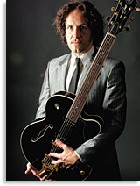
Considering his lengthy resumé, one might expect Irish guitarist Vivian Campbell would have released a solo album long before September of 2005. And Campbell’s efforts in bands such as Dio, Whitesnake, and Def Leppard might create a stereotype among listeners about the musical direction of the guitarist’s new album, but Two Sides of If (Sanctuary) is a surprise, genre-wise, in that it’s a blues tribute rather than a hard rock effort, and features contributions from ZZ Top’s Billy F Gibbons, vocalist Joan Osborne, and drummer Terry Bozzio
VG spoke with the affable guitarist while he was on the road with Def Leppard, discussing guitars, influences, and his new album. Campbell is originally from Belfast, Northern Ireland, and we inquired if one of his earliest influences was fellow Irish guitarist the late Rory Gallagher (see feature in this section).
“Rory was my first guitar hero, the first concert I saw, and his live album was the first 12” record I owned. I got into him when I was about 12, right around the time of Irish Tour ’74. I wanted a Strat bad; I had a Strat copy, but I was working weekends, trying to save up money. My father finally bought me a Fender, and surprised me with it. He opened up the trunk of his car, and there was a Telecaster (Thinline) – the one with the two humbuckers and an f-hole. That was my first real guitar.”
“Then I really got into (Thin Lizzy guitarists) Brian Robertson and Gary Moore,” Campbell added. “They were Les Paul cats, and by the time I got into Sweet Savage, I was a Les Paul guy.”
Campbell refinished his first Les Paul more than once and played it on the first album by singer Ronnie James Dio’s self-monikered band following Dio’s departure from Black Sabbath. Campbell was 19 years old when he got the Dio gig. By the time of the second Dio album, Campbell had acquired a couple of Charvel Strats from Grover Jackson. After departing Dio, he joined mega-group Whitesnake at the height of that band’s popularity in 1987, and he was an endorser of the Kramer Nightswan model, which had two humbuckers and a reverse headstock. Campbell later formed a short-lived band called Riverdogs, which “made one record that totally fell between the cracks.” He had also attempted to start a solo album in the early ’90s.
“Musically, it was going to be very different for me,” he explained. “I grew up very much a guitar guy, and was writing songs for Dio that were guitar-based. But after doing it for a couple of years with that band, I felt very conflicted, and for the first time in my life I started to listen to soul and pop singers, and I started vocal lessons.”
The guitarist’s shot at a solo effort was abruptly halted when he got a phone call about joining Def Leppard following the death of guitarist Steve Clark in 1991. His first performance was at the Freddy Mercury memorial concert in ’92, followed by tours to support Leppard’s Adrenalize album. He’s been with the band ever since and these days is back to favoring Les Pauls.
As with a lot of original blues recordings, Two Sides of If was done live in the studio. Moreover, blues is typically associated with older guitars, so we asked Campbell if he’d made a conscious decision to use vintage instruments on the album.
“I have a few Gibson reissues,” he said. “So they’re not ‘old’ guitars. I was jamming in a lot of clubs around L.A., and the guitar I was using most was a ’56 Les Paul reissue with P-90s, and I used that a lot on the record. I also borrowed some guitars from Gibson – a dot-neck 335, and an L-5 Custom, a big-bodied jazz guitar of the sort I’d never played before. They all sounded beautiful.
“I put a list on the CD of what gear I used on each song,” Campbell noted. “And the real surprise guitar, for me – the one I used most of the album – was a great-sounding new Yamaha with a Bigsby (vibrato). I also took that guitar to jams around L.A., and people would come up and ask me about it. It turned out to be the shining star of the record.”
Two Sides of If has 12 tracks, including two tributes to Gallagher. “Calling Card” gets particularly close to Gallagher’s tone. “I’ve got to say that comes more from my style of playing, but Rory’s definitely the primary influence, and I did pick up a lot of his habits; I definitely attack too much with my right hand. But I’m particularly pleased with the way the guitar sounded on that song; that was the Yamaha, and I used a Fender tweed amp that (Leppard guitarist) Phil Collen’s guitar tech modified. I think that tonally, that’s probably my favorite song on this record.”
Singer Joan Osborne contributes vocals on a cover of Cream’s “Spoonful,” and the redoubtable Billy F Gibbons wrote and performed on “Willin’ for Satisfaction,” and trades guitar licks with Campbell on a version of Fleetwood Mac’s “Like It This Way.”
Summing up the album, Campbell noted, “I’m really satisfied with the way it turned out. A lot of people wouldn’t expect it. My wife has always been a blues fan, and she told me 20 years ago ‘You play guitar like a blues guy, and you’ve got this rough voice, so you sing like a blues guy. You should make a blues record.’ It finally happened, and nobody knows me as a singer, and some people who think they know me as a guitar player will be surprised, as well. I’m not the same guitar player I was 20 years ago. I’ve come a long way since then.”
This article originally appeared in VG‘s Jan. ’06 issue. All copyrights are by the author and Vintage Guitar magazine. Unauthorized replication or use is strictly prohibited.


